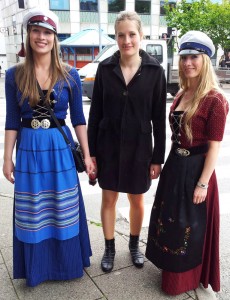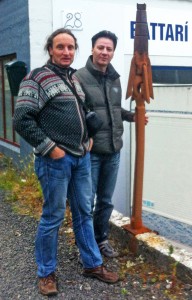Having just returned from a trip to the Faroe Islands once more to spark a conversation on the islands’ controversial pilot whale hunt, two dolphin advocates talked with Digital Journal about their experiences.
By Elizabeth Batt
Last year it was Taiji, Japan, this year the rugged and remote Faroe Islands. Hearts in hands, Sasha Abdolmajid and Hans Peter Roth approached the issue of the grindadráp, much as they had approached Taiji, with a willingness to listen and a spirit of cooperation.
They were surprisingly well-received. Abdolmajid told DJ that both of them were welcomed into the home, “of a man who is is said to have killed over one hundred pilot whales in his life so far.” It was a situation that might have been awkward, uncomfortable even, surrounded as they were by community locals, but here we sat, Abdolmajid added, “with this incredibly open dialogue about the centuries old pilot whale hunt.”
Still, neither of them could have prepared for what happened next.
“I have to add I am against the whale hunt and I am not afraid to say that,” said a 28-year-old local, who Abdolmajid and Roth named Hanna. “We had not expected locals, especially not in a small rural Faroese town, to be outspoken against the grindadráp,” Roth, a Swiss-based journalist explained.
A second question from another local named Kristian* seemed almost inevitable, “Why are you here?” he asked. Abdolmajid, an independent activist, responded honestly. “We would like to see the grindadráp end, sooner rather than later, so we’re seeking like-minded locals, to reassure and support them and to connect them among themselves,” he said.
The grindadráp
The pilot whale hunts, called the grindadráp or the grind in Faroese, are conducted on a non-commercial basis and are a community-wide event. When a pod of pilot whales are sighted, the alarm is sounded and locals head for their boats. Forming a wide semicircle around the pod, the whales are driven into a designated area. After being herded into the shallows, the whales are individually slaughtered with a special whaling lance that severs the spine.
The annual slaughter numbers change each year. According to ASCOBANS, between 1991 to 2011 in the Faroe Islands, annual catches ranged from zero (in 2008) to 1,572 (in 1992).
Abdolmajid’s answer to why they were there had sparked an interest in Hanna. She was against the hunt, she told them, but admitted that she was struggling for answers when friends asked her why the grind should be stopped. For Hanna, an incident in 2010, had forever turned her away from the drive hunt. The infamous grindadráp at Klaksvík, was a hunt that went “horribly wrong,” she told the duo. “Since that day I’m totally against it.”
We asked Roth what happened at Klaksvík? The journalist explained:
On July 19th 2010, during the largest drive in the past six years, 228 pilot whales were beached in the town of Klaksvík, even though officially there is only space to beach about 100 pilot whales. This leads to chaos and a massacre. Very few men were there who had proper knowledge on how to kill pilot whales quickly; they were overwhelmed by the number animals on the beach, the rocks and everywhere.
Many young men literally slit the animals open with their knives to bleed and kill them, but some did not succeed quickly at all. The drive left many residents of Klaksvík appalled and in shock, even though most of them are (or were to that point) in favor of the grindadráp.
Sadly, this is by far not the only irritating incident. Reports prove that locals in various areas of the designated 22 killing beaches had killed dolphin species that are protected even by Faroese law, such as Rissos’ dolphins or orcas. (In 1978, a unique hunt involving orcas did occur in the Faroe Islands. It has never been repeated).
In at least one case, almost the whole catch of a total of 62 pilot whales had to be dumped out at sea unused because their meat had gone bad. The whales had been killed relatively late at Víðvík on November 10th 2010, and were abandoned without being gutted when night fell. The next morning most of the meat was spoiled.
With public focus primarily on the pilot whale hunts, the deaths of protected species sometimes fly under the radar. But the islands are also frequented by other cetaceans, such as orcas. These killer whales Abdolmajid and Roth told me, are known to employ a unique hunting technique in the region:
The inhabitants of the Southern island, Suðuroy, have repeatedly seen orcas lying in wait very close to the rocky coastline and then suddenly leap out of the water to snatch an unsuspecting eider duck or shag off the rocks. For this reason the orca is also called the Eider-Whale by the locals. That was a real surprise to us. So far we had only heard of orcas catching some seal species this way.
The duo learned of these hunting strategies they said, from the Faroe Islands Whale Watch, an orca research facility that runs a visitor center in the capital city of Tórshavn. “It opened this summer and has been greeted with considerable interest by the locals,” said Roth. “The focus of the center is the photo-identification of the orcas around the Faroe Islands.”
Roth added:
A funny fact is that the Faroese have great respect for killer whales and there is widespread consent on how highly intelligent they are (not to forget, they are the closest relatives to pilot whales). There are reports of Faroese people being scared to death when they happened to be followed by curious pilot whales in their boats. They sped up their boats, but the orcas continued to follow them, which scared the locals even more, though most likely the orcas were just playful.
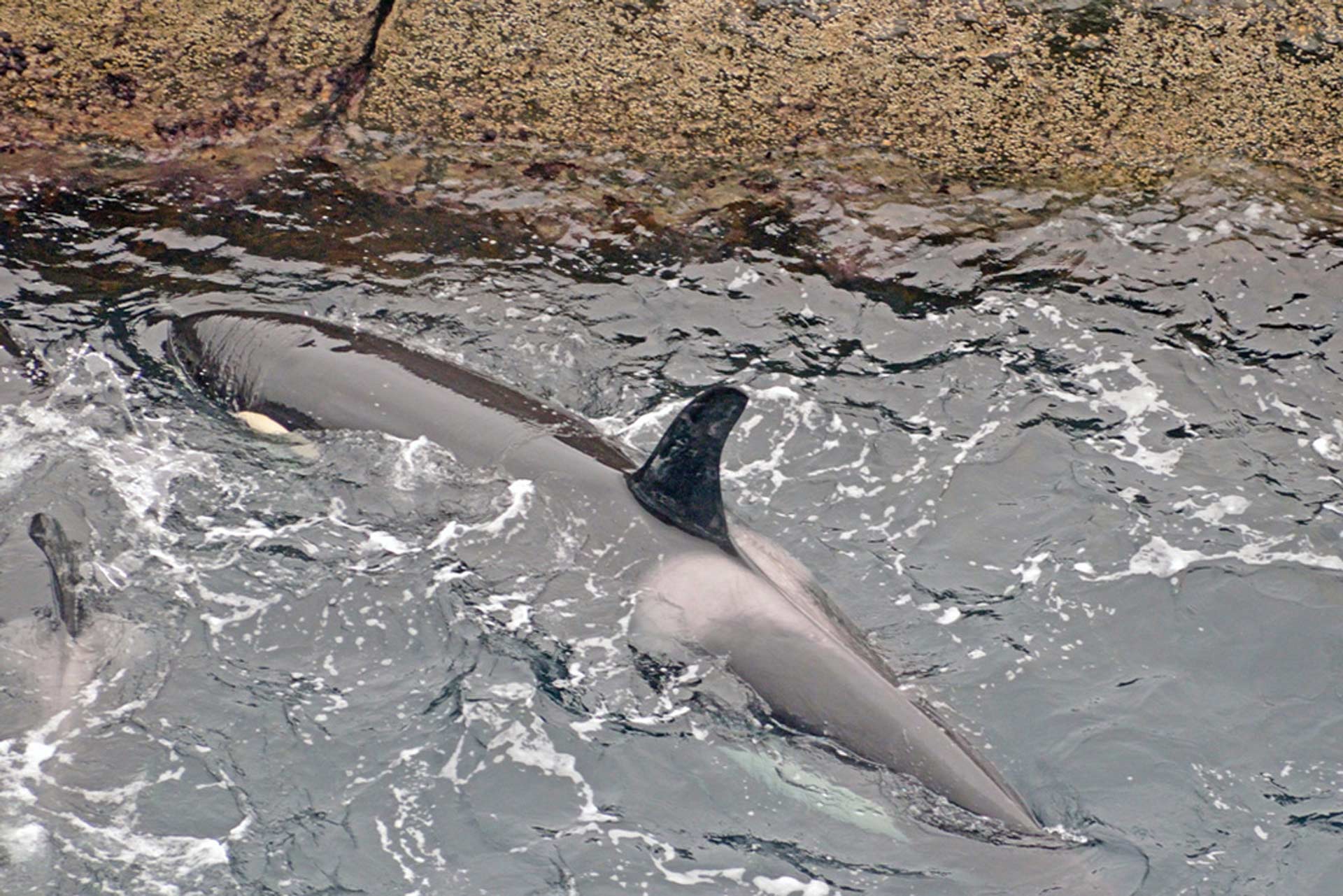
Picture taken Sept. 2012 by Planet Whale’s research team on the island of Suðuroy. This female orca has been identified and named as “Cristina.” Photo: Mark Hosford, Planet Whale
For Kristian, the connection to orcas was strong. Abdolmajid and Roth said he showed particular concern over their welfare and asked if there were still any countries that hunted the beautiful apex predators. For the visiting advocates, the door inched open wider and offered an opportunity to educate that was not to be missed. Abdolmajid said:
Kristian acted surprised about the results of scientific studies that prove dolphins (pilot whales are also a dolphin species) to be self-aware. For instance if they see themselves in the mirror and are fully aware of their individual existence. Sadly this makes them well aware of what is about to happen to them and their pod when they are driven onto a beach and get slaughtered. An even bigger surprise to him was the fact that pilot whales are the orcas closest relatives in the dolphin family. We were happy to provide him with a DVD of The Cove movie, since he also showed interest in the Japanese dolphin hunt.
The medical pitfalls of eating pilot whale meat
Summertime in the Faroe Islands, is a time of celebration and parties. “Dried pilot whale meat is served, a popular delicacy,” said Abdolmajid. Yet, added the advocate, “younger generations are refraining from eating it more and more.”
Roth elaborated:
Children and young women will hardly touch it, especially women if they are pregnant or want to have children. Otherwise friends will warn them. This cetacean meat and blubber is simply too heavily contaminated with toxins, most of all mercury and PCB’s. Nowadays this is common knowledge among the approximately 48,000 inhabitants on the Faroe Islands. This is in considerable part due to one Faroese man: Dr. Pál Weihe, Chief Physician of the Faroese Department of Occupational Medicine and Public Health.
It was under suggestions from Dr. Weihe in 2008, that the Faroese Health Ministry published an advisory to limit or refrain from the consumption of pilot whale meat.
Abdolmajid explained:
The recommendation resulted in much debate amongst locals, but today there is little dispute about the facts. In an interview we did with Pál Weihe in June 2013, he confirmed the validity of his studies after more extensive additional research, double checking and up-to-date studies of the issue have been undertaken.
In neuropsychological testing of children for instance, his team found impact of mercury on several fronts: in the brain, for example, in reaction time, in memory, in language. In other areas, they found indications of impairment. “Not a large impairment,” said Weihe, but they all went in the same negative direction.
Additional research by Weihe and other departments, such as the Environment Agency, also confirmed the validity and importance of Dr. Weihe’s findings. “These are yet more stepping stones towards the end of the whaling and why it should just belong to museums and history books,” added Abdolmajid.
Changing attitudes
Both Abdolmajid and Roth told DJ that attitudes are changing in the Faroe Islands and not just about the grindadráp. “There is growing demand for eco-tourism and the Faroes are well fit for it,” said Abdolmajid. The Faroes consist of 18 islands in the middle of the North Atlantic Ocean. Located northwest of Scotland and halfway between Iceland and Norway, no matter where you are on the islands, you’re never more than three miles away from the ocean.
Roth elaborated on their appeal and the growing awareness of their environment:
The islands are beautiful, and tourists currently come to visit for the dramatic scenery and seabird cliffs. They would like to see this eco-tourism developed, as well as understanding more about marine mammals.
It is fascinating to see the growing interest of the Faroese in whales other than pilot whales and other than just a marine resource. As cetaceans surface around the islands, they now also surface in the news. The attitude is changing – at least little by little. Meanwhile the Faroese – perhaps the most hospitable people we have ever met – are also proud of their cultural heritage; and this is certainly justified.
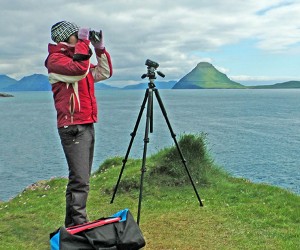
Land-based whale watching on the West side of Streymoy, the main island of the Faroes. Photo: Sasha Abdolmajid
In ages past, the Faroese depended upon pilot whale meat for survival. With land unfit for agriculture, the isolated islanders had to depend almost entirely on fishing, some livestock and also on pilot whales.
But there is a gradual shift in islander’s attitudes and both advocates believe that to help that along, the issue of the grindadráp should be handled with care and consideration for the culture and history of the islands.
“There are various reasons to pay tribute to this culture for its endurance and capability to survive in such harsh environment,” Roth said, “on the other hand the Faroese have many reasons to pay tribute to the pilot whales, as these cetaceans have essentially contributed to the survival of the Faroese people and culture. So why not celebrate them instead of hunting them?”, he added.
Kristian is not a pilot whale hunter, Abdolmajid told DJ, but although he is not against the hunt and likes to consume the meat or blubber every now and then, “he would not really mind, if the hunting died down,” Abdolmajid explained. But Kristian was also distinctly clear over foreigners who visit the Faroe’s without any knowledge. If their purpose was just to yell at the locals and point fingers, they would find little acceptance when they arrived.
“Friendliness is the key,” said Roth, along with, “openness, dialogue, to listen and learn, to exchange information and ideas and to understand each other. This is something already happening on the Faroe Islands.”
For emphasis, both Roth and Abdolmajid point to a quote by fellow Canadian advocate and book author, Leah Lemieux. “If you want the Faroese to make friends with the whales,” she told them, “you need to make friends with the Faroese.“
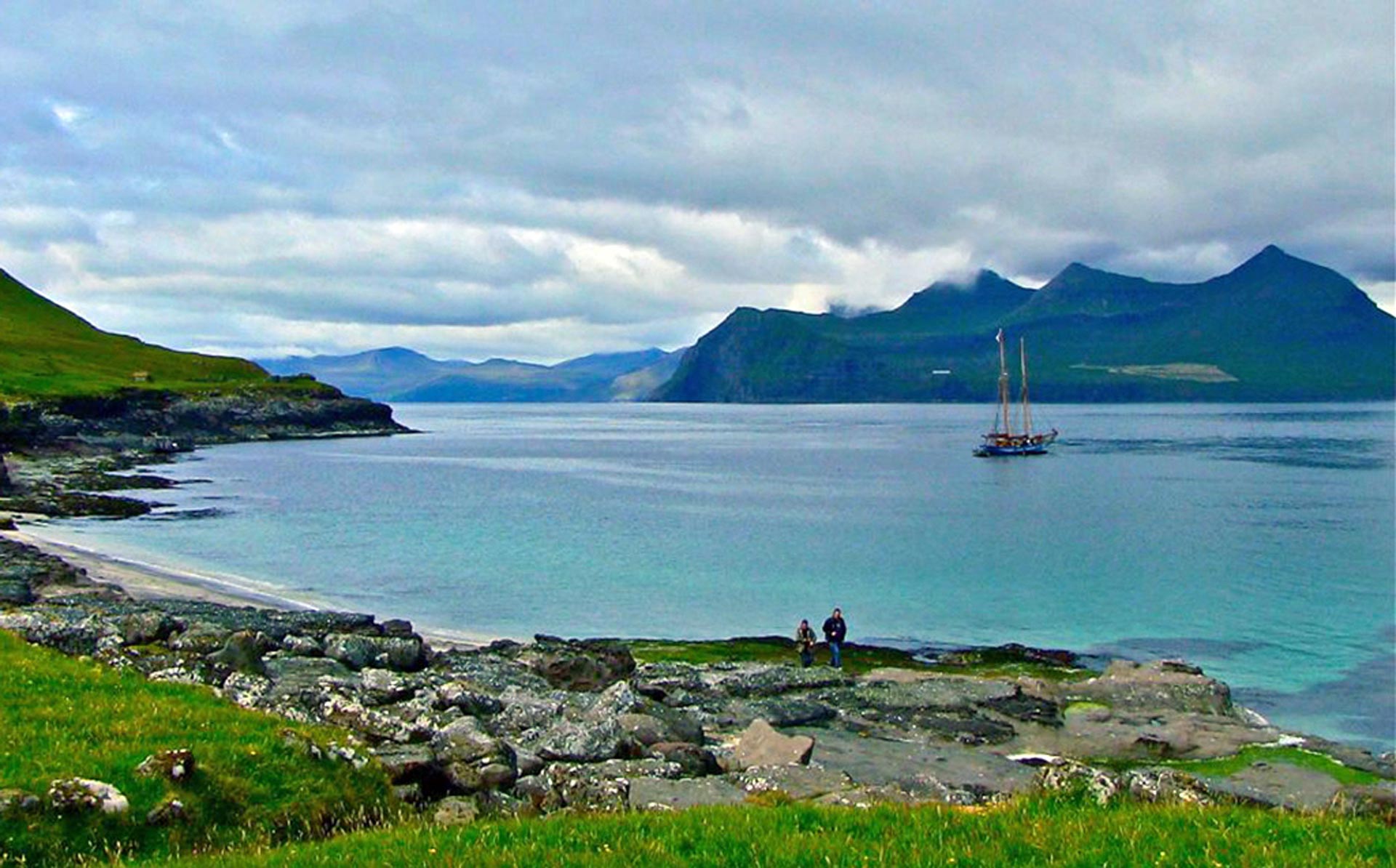
One of the Faroe Islands, Koltur is located to the west of Streymoy. Abandoned in the 1980s by sheep farmers, two people returned there in 1994 to restore the village. Photo: Hans Peter Roth
Abdolmajid is in agreement. “It’s hospitable, open and welcoming people that make dialogue and exchange so easy,” he said. “It is up to us to decide whether we want to isolate the Faroese, point fingers at them and thus prolong things like the grindadráp, by forcing them into a state of reluctance,” he added, “and it is up to us, not to do so and thus avoid needless vicious circles.” Roth added, “approached in the right way, the Faroese are very open for dialogue.”
*Name changed



